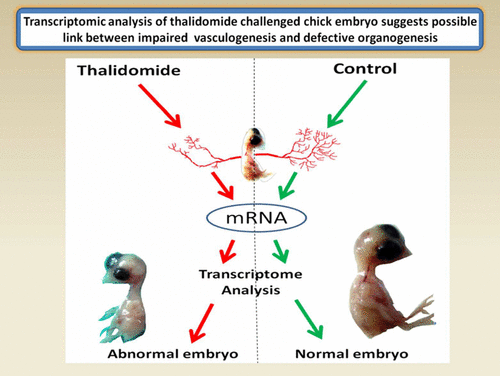当前位置:
X-MOL 学术
›
Chem. Res. Toxicol.
›
论文详情
Our official English website, www.x-mol.net, welcomes your
feedback! (Note: you will need to create a separate account there.)
Transcriptomic Analysis of Thalidomide Challenged Chick Embryo Suggests Possible Link between Impaired Vasculogenesis and Defective Organogenesis
Chemical Research in Toxicology ( IF 3.7 ) Pub Date : 2017-09-27 00:00:00 , DOI: 10.1021/acs.chemrestox.7b00199 Vimal Veeriah , Pavitra Kumar , Lakshmikirupa Sundaresan , Zeenath Mafitha , Ravi Gupta 1 , Uttara Saran , Jeganathan Manivannan , Suvro Chatterjee
Chemical Research in Toxicology ( IF 3.7 ) Pub Date : 2017-09-27 00:00:00 , DOI: 10.1021/acs.chemrestox.7b00199 Vimal Veeriah , Pavitra Kumar , Lakshmikirupa Sundaresan , Zeenath Mafitha , Ravi Gupta 1 , Uttara Saran , Jeganathan Manivannan , Suvro Chatterjee
Affiliation

|
Since the conception of thalidomide as a teratogen, approximately 30 hypotheses have been put forward to explain the developmental toxicity of the molecule. However, no systems biology approach has been taken to understand the phenomena yet. The proposed work was aimed to explore the mechanism of thalidomide toxicity in developing chick embryo in the context of transcriptomics by using genome wide RNA sequencing data. In this study, we challenged the developing embryo at the stage of blood island formations (HH8), which is the most vulnerable stage for thalidomide-induced deformities. We observed that thalidomide affected the early vasculogenesis through interfering with the blood island formation extending the effect to organogenesis. The transcriptome analyses of the embryos collected on sixth day of incubation showed that liver, eye, and blood tissue associated genes were down regulated due to thalidomide treatment. The conserved gene coexpression module also indicated that the genes involved in lens development were heavily affected. Further, the Gene Ontology analysis explored that the pathways of eye development, retinol metabolism, and cartilage development were dampened, consistent with the observed deformities of various organs. The study concludes that thalidomide exerts its toxic teratogenic effects through interfering with early extra-embryonic vasculogenesis and ultimately gives an erroneous transcriptomic pattern to organogenesis.
中文翻译:

沙利度胺挑战小鸡胚胎的转录组学分析表明血管生成受损和器官发生缺陷之间可能存在联系。
自从沙利度胺被认为是致畸剂以来,已经提出了大约30种假说来解释该分子的发育毒性。但是,还没有采用系统生物学方法来了解这种现象。拟议的工作旨在利用全基因组RNA测序数据,探索转录组学背景下沙利度胺对发育雏鸡胚胎的毒性作用机理。在这项研究中,我们挑战了血岛形成阶段(HH8)的发育中胚胎,这是沙利度胺诱发的畸形最脆弱的阶段。我们观察到沙利度胺通过干扰血岛的形成影响了早期的血管生成,从而将影响扩展到了器官发生。孵化第六天收集的胚胎的转录组分析表明,肝脏,眼睛,由于沙利度胺治疗,与血液组织相关的基因被下调。保守的基因共表达模块还表明参与晶状体发育的基因受到严重影响。此外,基因本体分析发现,眼睛发育,视黄醇代谢和软骨发育的途径被抑制了,这与观察到的各个器官的畸形一致。研究得出的结论是,沙利度胺通过干扰早期胚外血管生成而发挥其毒性致畸作用,并最终为器官发生提供错误的转录组模式。基因本体分析发现,眼睛发育,视黄醇代谢和软骨发育的途径受到抑制,这与观察到的各个器官的畸形一致。研究得出的结论是,沙利度胺通过干扰早期胚外血管生成而发挥其毒性致畸作用,并最终为器官发生提供错误的转录组模式。基因本体分析发现,眼睛发育,视黄醇代谢和软骨发育的途径受到抑制,这与观察到的各个器官的畸形一致。研究得出的结论是,沙利度胺通过干扰早期胚外血管生成而发挥其毒性致畸作用,并最终为器官发生提供错误的转录组模式。
更新日期:2017-09-28
中文翻译:

沙利度胺挑战小鸡胚胎的转录组学分析表明血管生成受损和器官发生缺陷之间可能存在联系。
自从沙利度胺被认为是致畸剂以来,已经提出了大约30种假说来解释该分子的发育毒性。但是,还没有采用系统生物学方法来了解这种现象。拟议的工作旨在利用全基因组RNA测序数据,探索转录组学背景下沙利度胺对发育雏鸡胚胎的毒性作用机理。在这项研究中,我们挑战了血岛形成阶段(HH8)的发育中胚胎,这是沙利度胺诱发的畸形最脆弱的阶段。我们观察到沙利度胺通过干扰血岛的形成影响了早期的血管生成,从而将影响扩展到了器官发生。孵化第六天收集的胚胎的转录组分析表明,肝脏,眼睛,由于沙利度胺治疗,与血液组织相关的基因被下调。保守的基因共表达模块还表明参与晶状体发育的基因受到严重影响。此外,基因本体分析发现,眼睛发育,视黄醇代谢和软骨发育的途径被抑制了,这与观察到的各个器官的畸形一致。研究得出的结论是,沙利度胺通过干扰早期胚外血管生成而发挥其毒性致畸作用,并最终为器官发生提供错误的转录组模式。基因本体分析发现,眼睛发育,视黄醇代谢和软骨发育的途径受到抑制,这与观察到的各个器官的畸形一致。研究得出的结论是,沙利度胺通过干扰早期胚外血管生成而发挥其毒性致畸作用,并最终为器官发生提供错误的转录组模式。基因本体分析发现,眼睛发育,视黄醇代谢和软骨发育的途径受到抑制,这与观察到的各个器官的畸形一致。研究得出的结论是,沙利度胺通过干扰早期胚外血管生成而发挥其毒性致畸作用,并最终为器官发生提供错误的转录组模式。











































 京公网安备 11010802027423号
京公网安备 11010802027423号